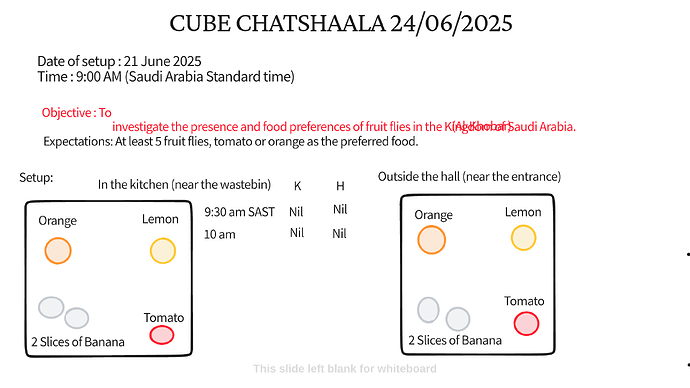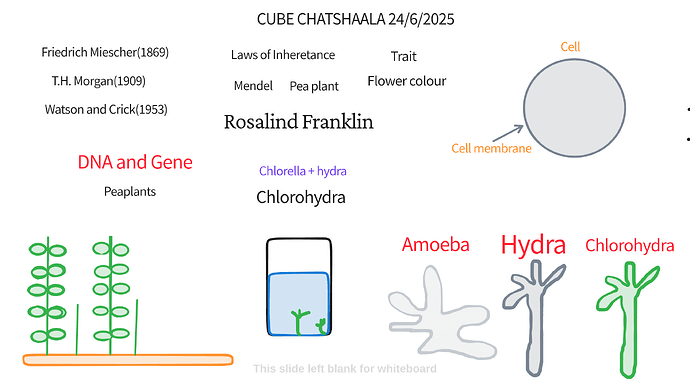@Arunan @KiranKalakotiR @sakshiconsultant2002 @Theertha @dhanraj7 @Sailekshmi @2020ugchsncnseethala
![]() Session Overview
Session Overview
Date: 21 June 2025 (setup)
Time: 9:00 AM SAST (Saudi Arabia Standard Time)
![]() Objective & Expectations
Objective & Expectations
Investigate the presence of fruit flies
Determine food preferences (choices: tomato, orange, lemon, banana)
Expectation: At least 5 fruit flies, with tomato or orange being preferred
![]() Experimental Setup & Observations
Experimental Setup & Observations
Locations & Bait Placement
- Kitchen (near waste bin)
-
Baits: orange slice, lemon slice, tomato, two banana slices
-
Observation times: 9:30 AM, 10:00 AM (no fruit flies detected at either interval)
- Outside the hall (near entrance)
Same bait setup as kitchen
- Observations at same times
No fruit flies seen
Summary
-
No fruit flies present at either location during the observed time
-
No preference inferred, as count was zero
![]() Discussion Notes from Whiteboard
Discussion Notes from Whiteboard
Key Scientific Figures & Concepts
![]() Friedrich Miescher (1869) – discovery of nucleic acids
Friedrich Miescher (1869) – discovery of nucleic acids
![]() Thomas Hunt Morgan (1909) – early genetics in fruit flies
Thomas Hunt Morgan (1909) – early genetics in fruit flies
![]() Watson & Crick (1953) – elucidation of DNA double helix
Watson & Crick (1953) – elucidation of DNA double helix
![]() Mendel’s laws of inheritance, using pea plant traits (e.g., flower colour)
Mendel’s laws of inheritance, using pea plant traits (e.g., flower colour)
Highlighted Scientist
- Rosalind Franklin – her contributions to DNA structure via X‑ray diffraction
![]() Live Organism Examples
Live Organism Examples
Chlorella + Hydra – studied together as Chlorohydra
Other simple organisms illustrated: Amoeba, Hydra, Chlorohydra
![]() Cell Diagram
Cell Diagram
Basic representation of a cell (membrane and interior)
![]() Key Takeaways
Key Takeaways
-
No fruit flies were captured during the trial—likely due to timing, bait placement, or environmental conditions
-
Reinforcement of fundamental genetics and cell biology concepts
-
Introduction to microorganisms and symbiotic or associative studies (e.g., Chlorella + Hydra)
![]() Follow-up Queries
Follow-up Queries
- Fruit Fly Study
-
Would extending the observation period or changing bait placement/time increase fruit fly capture?
-
Could different baits (e.g., ripened mango or over-ripe banana) yield different results?
- Genetics & History
-
How did Rosalind Franklin’s X-ray diffraction technique complement Watson & Crick’s model?
-
What are Mendel’s laws, and how do they apply to pea plant traits like flower colour?
- Microorganism Studies
-
What is Chlorohydra, and how do Chlorella and Hydra interact in that system?
-
How do simple organisms like amoeba and hydra exemplify basic cellular functions?
‐‐-

